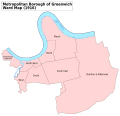Greenwich (UK Parliament constituency) facts for kids
Quick facts for kids {{{Name}}}[[{{{Type}}} constituency]] |
|
|---|---|
| [[Image:{{{Map1}}}Constituency.svg|120px|]] [[Image:England{{{Map2}}}.svg|120px|]] |
|
| {{{Name}}} shown within [[{{{Entity}}}]], and {{{Entity}}} shown within England | |
| Created: | {{{Year}}} |
| MP: | {{{MP}}} |
| Party: | {{{Party}}} |
| Type: | House of Commons |
| County: | [[{{{County}}}]] |
| EP constituency: | [[{{{EP}}} (European Parliament constituency)|{{{EP}}}]] |
Greenwich was a special area in south-east London. For many years, people living there voted for someone to represent them in the UK Parliament. This person is called a MP.
At first, Greenwich chose two MPs. But from 1885, it chose only one. This system of voting is called "first past the post." It means the candidate with the most votes wins. The Greenwich area was a parliamentary constituency from 1832 until 1997.
Contents
History of Greenwich as a Voting Area
How Greenwich Changed Over Time
From 1832 to 1885, Greenwich was a "two-member" area. This meant voters chose two people to be their MPs. Later, in 1885, the rules changed. The area of Greenwich that voted became a bit smaller. From then on, it became a "one-member" area, choosing only one MP.
For the 1997 general election, the Greenwich voting area joined up with part of the old Woolwich area. Together, they formed a new voting area called Greenwich and Woolwich.
Famous Moments and People
The history of Greenwich as a voting area is closely linked to its strong connection to the sea. One of its most famous MPs was William Ewart Gladstone. He was an MP for Greenwich between 1868 and 1880. He even became the Prime Minister!
Greenwich also became well-known during a special election in 1987. This was called the 1987 Greenwich by-election. A political party called the SDP won by surprise.
Where Was Greenwich?
The boundaries of the Greenwich voting area changed several times. Here's a simple look at how it changed:
Greenwich Boundaries: 1832–1885
In these years, Greenwich included the areas of Greenwich, St Nicholas and St Paul Deptford. It also covered the busiest parts of Charlton and Woolwich. The exact lines were set out in a law in 1832.
Greenwich Boundaries: 1885–1918
During this time, the voting area included the parishes of Greenwich, St Nicholas Deptford, Charlton, and Kidbrooke.
Greenwich Boundaries: 1918–1974
For many years, the voting area was the same as the Metropolitan Borough of Greenwich.
Greenwich Boundaries: 1974–1983
The area then included specific parts of the London Borough of Greenwich. These were the wards of Blackheath, Charlton, Eastcombe, Hornfair, Kidbrooke, Marsh, Park, Trafalgar, Vanbrugh, and West.
Greenwich Boundaries: 1983–1997
In its final years, the voting area covered the western part of the Royal Borough of Greenwich. It included the wards of Blackheath, Charlton, Ferrier, Hornfair, Kidbrooke, Rectory Field, St Alfege, Trafalgar, Vanbrugh, and West.
Members of Parliament for Greenwich
Over its history, many different people served as MPs for Greenwich. These individuals represented the people of Greenwich in the UK Parliament. They worked to bring local issues to the government's attention. They also voted on national laws.
From 1832 to 1885, two MPs represented Greenwich at the same time. After 1885, only one MP was elected for the area. The MPs came from different political parties over the years. These included the Whigs, Radicals, Conservatives, Liberals, and Labour.
One notable MP was William Ewart Gladstone, who represented Greenwich from 1868 to 1880. He later became a very important Prime Minister. Another MP, Rosie Barnes, won a surprising victory in a special election in 1987.
Images for kids







